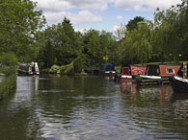
Canals and forests, going, going….goneHaving nationalised the banks, Britain’s Labor government looks set to sell off the country’s forests and waterways to private buyers, in an attempt to balance the books ahead of the next election.
The Forestry Commission which manages the country’s forest stock and British Waterways,the body that manages Britain’s rivers and canals, both control huge swathes of land that would be ideal for off-grid living. In the event they were sold, these possibilities may disappear, although they may also move up the agenda as the new owners attempt to maximise profitablity.
British Waterways currently allows live-in vessels to moor on a tiny fraction of the potential total moorings.
The Forestry Commission is already in detailed discussions to establish off-grid communities in a 100,000 acre wood in Lincolnshire amongst others.
The two companies and other government owned organisations will be groomed for sale by the Shareholder Executive, the body charged with improving the government’s performance as a shareholder.
The British Administration set a target of raising £36 billion from disposals by 2011. More than £18 billion has been raised so far, much of it by offloading land and buildings at knock-down prices to building companies and speculators who have just added it to their stockpiles.
A national inventory of trees by the Forestry Commission has revealed that 11.8% of Britain is forested. About 8.5% of England is covered by them, 14.2% of Wales is forested, as is 17.2% of Scotland. Britain’s tree cover is still thin by European standards (the EU average is about 33%), but things are looking greener than they were in 1895, when less than 5% of Britain was woodland.
Almost all of this growth is due to the Forestry Commission, set up in 1919 to ensure, among other things, a domestic supply of pit props and railway sleepers after the demands of the industrial revolution, followed by the first world war, had more or less stripped the country of timber. A tax break encouraged landowners to take up tree-planting, too. And since softwoods grow faster than hardwoods, the public and private sectors blanketed hillsides in gloomy Sitka spruce.
The tax-breaks were abolished in 1988, and the Sitka spruce have turned out to be a commercial disaster. Forests planted in the 1960s and 1970s are now reaching harvest age; production in Scotland is forecast to rise from about 4m cubic metres now to 10m cubic metres in 2020. But wood prices, thanks to the impact of paper recycling and the growth of cheap wood imports from Baltic countries, have fallen to their lowest ever. Scottish forests also tend to be in remote places where roads are bad or non-existent.
Planting is now lower than at its peak in the late 1980s, but forests are still spreading. Subsidies make forestry a reasonable alternative to arable, these days. The hand-outs are designed to encourage mixed, broad-leaf plantations. They are more popular with the clientele – the townies who want a breather – less prone to pest attack and they encourage a greater diversity of wildlife. Nearly three-quarters of trees now being planted are broad-leaved – oak, ash and birch are particularly popular. Fewer than a fifth of the conifers now being planted are the hated Sitka spruce.
British Waterways recently announced that more boats – 31,000 in total – used the waterways last year than at the height of the industrial revolution. In 2007, 11 million people used the waterways and surrounding land for a range of activities, including angling, cycling, walking, drinking at nearby pubs or simply feeding the ducks. These statistics provide ammunition for those who say that the nationalisation has been a success. However, it doesn’t come cheap.
‘The really good reason for nationalisation is that we’re so adaptable,’ says the agency’s chief executive, Robin Evans. ‘The canals were built to transport goods for the industrial revolution. Here we are 200 years later and they’re primarily a leisure resource. If they didn’t have a public use, they wouldn’t still be in public ownership. The not-so-good reason is that we cost the Government pounds 60 million a year: we couldn’t continue without government support.’
In 1948, when the transport arteries of the industrial revolution were nationalised, a government official in the newly-formed British Transport Commission remarked with surprise: ‘Oh, do we get the canals too?’
Funding cuts in recent years suggest that this nonchalant attitude persists. Although it would cost around £125 million a year to maintain the waterways properly, British Waterways can only afford to spend £105-110 million. Consequently, the agency has had to limit what it does.
As a result, it has been working hard to quantify the value it adds to local and national economies, so it can make a strong case for more support.